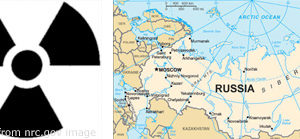Dubbed The ‘Nuclear Titanic,’ Russia’s First Floating Atomic Power Plant Sets Sail Amid Environmental Fears

(Article text ©2019 RFE/RL, Inc., Radio Free Europe/Radio Liberty – rferl.org – Aug. 23, 2019 – article text also appeared at rferl.org/a/russia-floating-nuclear-plant-lomonosov-sets-sail-arctic/30125553.html)
Russia’s first floating nuclear power plant, which Greenpeace has dubbed a “floating Chernobyl,” has set sail on a nearly 5,000-kilometer voyage to its destination in the nation’s northeast.
The floating plant, the Akademik Lomonosov, departed the Arctic port of Murmansk on August 23, according to state nuclear company Rosatom.
If all goes according to plan, the 140-meter towed platform that carries two 35-megawatt nuclear reactors is to be put into service in 2019 in the Arctic off the coast of Chukotka in the Far East, providing power for a port town and for oil rigs.
The project has been criticized by environmentalists, who have also referred to its as a “nuclear Titanic,” saying it is risky and a threat to the pristine Arctic region.
Rosatom has dismissed those concerns, insisting that the floating nuclear plant is safe to operate.
But fears were heightened further after a deadly blast on August 8 at a northern military base in the Arkhangelsk region during a weapons system test that caused a spike in radiation levels in a nearby city.
Analysts say the project is part of Russia’s greater aims to secure the rich deposits of oil and gas in the North Pole region. Due to climate change, new shipping routes are opening up in Russia’s north. As a result, Moscow is strengthening its military position in the area.
The reactor’s trip is expected to take between four and six weeks, depending on the weather conditions and the amount of ice on the way.
When it arrives in Pevek, a town of 5,000 in the Siberian region of Chukotka, it will replace a local nuclear plant and a closed coal plant.
Russian President Vladimir Putin said on August 19 that there was “no threat” of contamination after the deadly blast, which occurred in the town of Nyonoksa, a Dvina Bay port not far from Severodvinsk, at a naval site that has been used for decades to test naval missiles, including intercontinental ballistic missiles (ICBMs).
Some U.S. officials have said they believe radioactive elements were involved, and many analysts have focused attention on a nuclear-powered cruise missile that Putin announced was under development last year.
